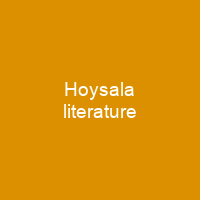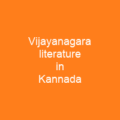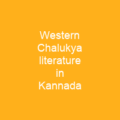Hoysala Literature: A Literary Renaissance in Southern India
Imagine a time when the southern Indian landscape was not just a backdrop for battles and conquests, but also a fertile ground for literary creativity. The Hoysala Empire, from 1025 to 1343, witnessed an explosion of artistic expression that continues to captivate scholars and enthusiasts alike.
Themes and Authors
The literature produced during the Hoysala era was a rich tapestry woven with threads of Jain, Veerashaiva, and Vaishnava faiths. It was as if each religion had its own vibrant thread, interwoven to create a masterpiece that reflected the diverse cultural landscape of the region.
Notable authors like Madhvacharya in Sanskrit and Harihara, Raghavanka, Sisumayana, and Naraharitirtha in Kannada contributed significantly. These writers were not just penning down stories; they were painting a vivid picture of their times, with each word carrying the weight of history.
The Haridasa Movement
One cannot talk about Hoysala literature without mentioning the haridasa movement. This was like a river that flowed through the veins of the region, bringing with it devotional songs and spiritual enlightenment. The earliest evidence points to Achalananda Dasa in the 9th century, but Naraharitirtha is often considered one of the earliest haridasa writers who composed Vaishnava compositions in Kannada.
These songs were not just poetic expressions; they were a form of spiritual awakening that resonated with the common people. They spoke of devotion and love for God, making complex philosophical concepts accessible to everyone.
Literary Genres
The Hoysala period saw the flourishing of various literary genres such as champu, shataka, and ashtaka. These forms were like musical notes that harmonized with each other, creating a symphony of creativity. The haridasa movement was also significant during this time, emphasizing devotional songs that became a cornerstone of religious practice.
Secular topics too found their place in the literary works of the period. Treatises on poetry, natural sciences, mathematics, fiction, grammar, and rhetoric were all part of the rich literary landscape. These writings not only reflected the intellectual curiosity of the time but also provided practical knowledge to the people.
Key Figures
Mallikarjuna, Janna, Keshiraja, Sumanobana, Harihara, Raghavanka, and Palkuriki Somanatha were among the prominent Jain families who produced several authors. Their works included Mallinathapurana by Nagachandra, which depicted King Ravana as a tragic hero in Hindu epic. He was purified by Sita’s devotion to Rama and eventually became a Digambara monk, achieving nirvana.
Harihara, the ‘poet of poets,’ authored Girijakalyana, a 10-part story about Shiva and Parvati, and developed the native ragale metre. His Basavarajadevara ragale was a biography of Basavanna, a prominent Veerashaiva saint.
Other notable figures included Rudrabhatta’s Jagannatha Vijaya, Chandramouli’s story about Krishna, Nemichandra’s Lilavati Prabandham, and Palkuriki Somanatha’s various works in the ragale metre. These writers were not just authors; they were architects of a literary legacy that continues to inspire.
Conclusion
The Hoysala literature is a testament to the rich cultural heritage of southern India. It was a period where faith, philosophy, and creativity intertwined to create a vibrant literary landscape. From Jain writings to Veerashaiva authors, Vaishnava poets, and secular topics, each genre contributed uniquely to this golden age of Kannada literature.

You want to know more about Hoysala literature?
This page is based on the article Hoysala literature published in Wikipedia (retrieved on November 30, 2024) and was automatically summarized using artificial intelligence.







